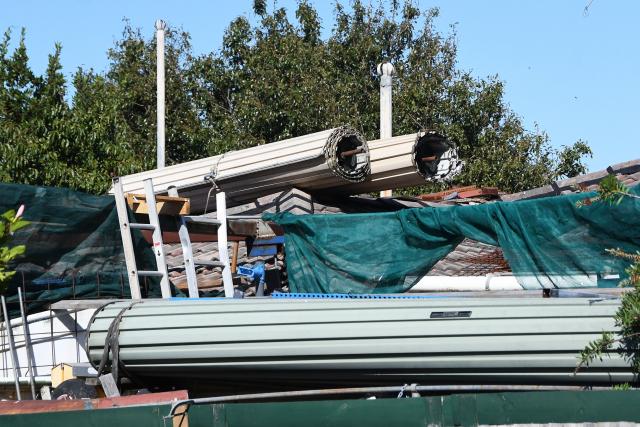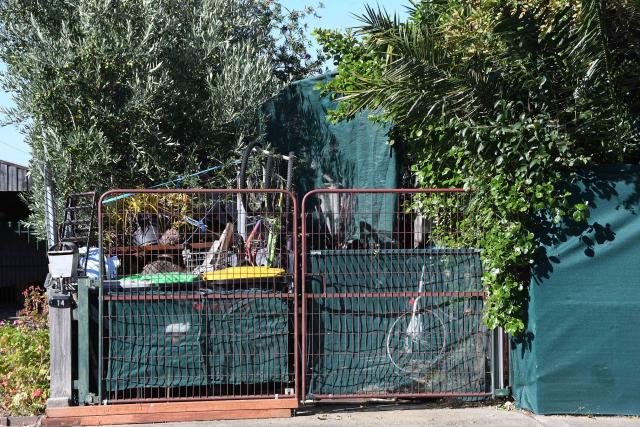A hoarder’s property stacked to the rooftop remains an eyesore and fire-risk for more than two decades despite regular complaints from neighbours.
The Noble Park home’s front and back yards are piled and packed with materials including an oil heater tank, roller doors, bikes and a bus with a dinghy on top.
Items are even piled on the garage roof, with an alleged illegal building structure shedding timber into a neighbour’s yard.
The exasperated neighbours, Ruth and Fred, are a couple in their 90s who have lived at their home since the 1960s.
They first complained to Greater Dandenong Council about the unsightly mounds in 2011 and it remains very much unresolved.
It makes Ruth feel like she’s in “a mad comedy show” and is “sick of the excuses”.
In the past, the council had made visits, sent letters and notices to the owner which resulted in a partial and temporary clean-up, she said.
But the alleged fire and vermin risk has continued largely unabated.
She’s worried about the ramshackle timber scaffolding that towers over their fenceline, as well as the safety of the occupier in his 70s who scales ladders to compile his collection.
“He says he had a permit to put a second storey on his house. I want that horrible mess taken off the fence.
“We have put up with roller doors, plastic crates, bikes and other rubbish next to us for years – the ‘construction’ was the last straw.
“His hoarding shouldn’t impact our lives – and the rest of our neighbourhood for that matter.”
Meanwhile Ruth was informed by Fire Rescue Victoria that the property was being added to its Hoarding Notification System so fire crews were aware of the “increased fuel load”.
FRV advised her to consider interconnected smoke alarms at her home and to ensure she had an emergency evacuation plan.
Greater Dandenong Council says it has a “long history” with the hoarder dating back to 2004.
“Over the past two decades we have worked with the owner to address a number of concerns,” a spokesperson said.
However, the issue has not yet been identified as a “hoarding concern” by the council’s public health team.
“The Public Health team becomes involved when all other avenues have been exhausted – this includes action under planning legislation, building legislation, or under Council’s Local Laws as an unsightly or overgrown property.
“The issue of hoarding is complex and multi-layered, and each case is unique. They often involve mental health issues and require patience, flexibility and understanding.”
In response to a councillor’s question at a meeting in January, a council officer stated that Greater Dandenong was “resolving” a hoarding case in Springvale South.
It would be “used as an example to develop a procedure to deal with hoarding properties”.
“These are difficult and delicate situations that take many months of effort and resources from Council to resolve.
“We request the patience of the neighbours and the wider community during the coming months.”
Clinical psychologist Catherine Madigan said it was a “slow process” to treat extreme hoarding, which was often a complex mental condition. It can be underlined by depression, ADHD or perhaps growing up in poverty.
Cognitive behavioural therapy was available to treat hoarding disorders. However, only up to 10 sessions are subsidized by Medicare and very few psychologists bulk-bill.
Anti-depressant, ADHD and anti-anxiety medications may also help.
“Medication alone is not going to address the issue but might put them in a better state of mind.”
For the collector, the ‘junk’ may look like useful potential treasures for building things, or making arts and crafts.
Often when they’re told to clean up, it never happens, Madigan says.
“If they have got so much mess, it would be very overwhelming to clean up. The person wouldn’t know where to start.”
Madigan says forcibly removing the “stuff” and “throwing it in a skip” doesn’t address the problem.
“It’s traumatizing the person, they get angry and hostile and they go and collect another bunch of stuff. And you’re back to where you’ve started.
“Sometimes when people are given the right sort of encouragement and support, you can get them to get rid of some of their stuff.
“We’re not discounting the neighbours’ perspective but we want a long-term solution. A slow but steady approach rather than going in there and throwing their stuff out.”









